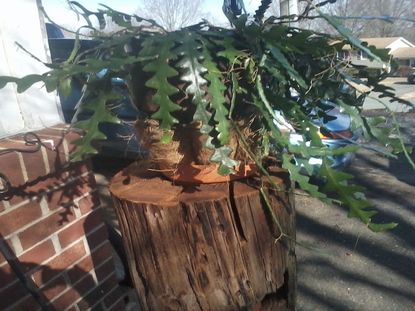Fishbone Cactus Complete Plant Care & Growing Guide
If you’re looking for an interesting hanging plant, try a fishbone cactus in your arrangement. Also known as ric rac cactus, it’s hardy and disease-free.


How To Grow And Care For A Fishbone Cactus
Architecturally appealing, fishbone cactus has an astounding silhouette. Also called ric rac cactus, the fishbone plant is a succulent with a form unlike any other. The plant is listed as either in the Epiphyllum or Cryptocereus genus. The confusion results in the fact that it is an epiphytic orchid cactus. It is grown not only for the amazing shape it produces, but also vibrant flowers.
Quick Facts
Botanical name: Cryptocereus anguliger
Height: 3 feet long ( .91 m.)
Spread: 2 feet ( .7 m.)
Sun exposure: Partial shade
Soil requirement: Well draining bark
Hardiness zones: USDA 9-11
Gardening tips, videos, info and more delivered right to your inbox!
Sign up for the Gardening Know How newsletter today and receive a free download of our most popular eBook "How to Grow Delicious Tomatoes."
When to plant: After flowering
Fishbone Cactus Care
Fishbone cactus, or zig-zag cactus as it is also known, grows in its natural range of Mexico in rainforests. Here it grows on trees and occasionally other crevasses. It does not harm the tree but takes its nutrients and moisture from the air and dropped detritus. Belonging to the Cryptocereus genus, it shares the habit of the flowers closing at night. The semi-rigid stems rise from the core and have serrated “bony” looking sections.
Light
Due to its habit of living on trees in a close rainforest canopy, the plant prefers partial shade. When grown indoors the plant should receive bright, indirect light such as that near a western side but a bit away from the window. If the cactus is grown outdoors, it should have protection from the noonday sun and receive partial shade, especially during the hottest part of the day. Excess exposure to light will cause the stems to redden and burn.
Water
This succulent can tolerate plenty of watering during the growing season. Provided the planting medium is freely draining, keep the soil moderately moist. During the winter months, the plant is dormant, and the soil should be allowed to dry out between watering. The plant will indicate a lack of water by its puckered stems. It is best to water zig zag cactus with room temperature water.
Temperature & Humidity
As a Mexican native plant, this is not a cold hardy specimen. Temperatures between 60- 77 degrees Fahrenheit (16-25 C) are ideal. It can tolerate the cooler end of this range in winter. Fishbone plants enjoy moderate humidity. In dry indoor conditions, place the container on a saucer of pebbles filled with water. This will evaporate and provide ambient moisture.
Soil
Ric Rac cactus is not truly an orchid but it does need the same type of growing medium. Use a purchased orchid mixture or make your own with a combination of shredded bark and sphagnum moss, with some perlite added. The medium must hold a bit of moisture but be freely draining.
Fertilizer
Feeding fishbone cactus will promote growth and blooming. Feed in spring monthly with a diluted houseplant food that is slightly higher in potassium. This will fuel the production of flowers. By mid-summer, change to a balanced fertilizer. Suspend feeding the plant in fall through the end of winter.
Problems, Pests & Diseases
One of the most common problems is root rot, which stems from overwatering and soil that doesn’t drain properly. Never let the base of the container rest in water. In warm regions where freezes don’t occur, the plant can be grown outside. This will leave it prey to insect pests such as mealy worms, aphids, and red spider mites. Use an alcohol spray to combat the pests. The plant is disease-free, except for fungal issues when it is overly wet.
How to Plant a Fishbone Cactus
Zig zag cactus makes an ideal hanging plant. Select a container that is just large enough to contain the plant. Purchase or make a porous, low-soil medium. Repot the plant after blooming. It should be repotted every 3 years. Gently tease the roots to help them spread if the plant is pot-bound and backfill with growing medium. Water the container to settle the medium around the roots.
Pruning
The fishbone cactus doesn’t need pruning, but it may be required if the stems get out of hand. Remove any dead stems from the point they begin to discolor. Use clean, sharp pruners to remove stems. Remove any stems that have discolored or yellowed.
Fishbone Cactus Propagation
Propagation by seed can be difficult and time consuming. A better method is vegetative. Remove the stems that were overgrown and allow them to callus for a few days. Then pot them up in the same growing medium in which the original plant was housed.
Repotting
Most plants need to be repotted every 1-3 years. As the nutrients in the medium are used up and the bark begins to decay, repot the fishbone cactus into fresh medium.
Overwintering
Plants that are grown outdoors in warmer climes, should be brought indoors for the winter if frost is expected. Temperatures below 45 degrees Fahrenheit (7 C ) can damage or kill the plant. If the plant is in the ground and a freeze is expected, drape it in frost protection fabric. Remove the fabric when the temperatures warm.
Making the Fishbone Cactus Flower
To encourage blooming, feed the plant with a high potassium food for a few months. The plant also responds to brighter light, and longer periods of light by producing buds. The flowers will open only during the day and close at night. Repotting the plant and giving the roots more room will also encourage blooming.
Fishbone Cactus Varieties
Epiphyllum anguliger is the most common ric rac cactus available. Other plants in other genuses are also called fishbone cactus but these have different attributes and are not the same plant. Selenicereus anthonyanus, Disocactus anguliger, and Weberocereus imitans are also called fishbone cactus.
FREQUENTLY ASKED QUESTIONS
Where Is the Best Place to Put a Fishbone Cactus?
Place the plant just inside a south or west facing window indoors. If the home is very gloomy, place it under a plant light for part of the day. Avoid situating it near drafty windows or doors. Outdoors, make sure the plant is in a partially sunny location with shade in the latter part of the day. Fishbone cactus makes an excellent hanging container plant.
Can a Fishbone Cactus Grow in Low Light?
While this plant does prefer partial shade, it will need a bit of light. In spaces such as office buildings where natural light is limited, the plant will do fine. In very dark spaces, provide artificial light for a couple of hours each day.

Bonnie Grant is a professional landscaper with a Certification in Urban Gardening. She has been gardening and writing for 15 years. A former professional chef, she has a passion for edible landscaping.
-
 "My Worst Mistake" – Gardeners Share 10 Hard-Learned Lessons
"My Worst Mistake" – Gardeners Share 10 Hard-Learned LessonsGardeners never stop learning, and sometimes our mistakes are the best teachers. But why not save time and heartache by learning from other gardeners' failures?
By Melanie Griffiths
-
 Crops for Urban Growing: 8 Edible Plants For Urban Gardens
Crops for Urban Growing: 8 Edible Plants For Urban GardensUrban edible gardening lets your yard do double duty of beauty and practicality. Have fun combining edible plants with ornamentals.
By Teo Spengler